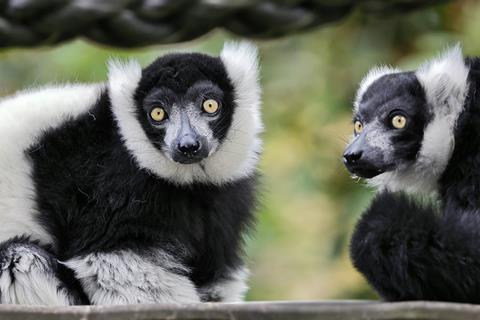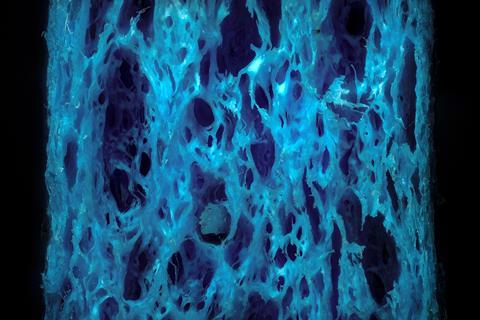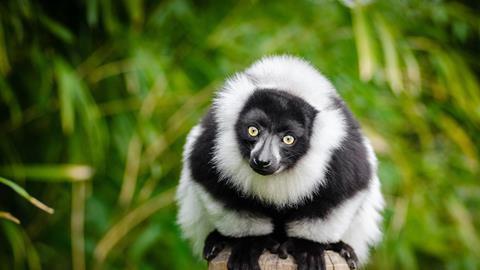Indris, the largest living lemurs of Madagascar, are classified as ‘Critically Endangered’ by the International Union for Conservation of Nature’s (IUCN) Red List of Threatened Species. The species is indeed facing a population decline, with significant habitat destruction and fragmentation primarily due to slash-and-burn agriculture, logging, and fuelwood gathering.
Indris are folivorous, arboreal primates that are considered immature leaf specialists. The species spends most of its feeding time on young leaves, although the diet can be integrated with mature leaves, fruits, bark, flowers, and buds. With more than 100 plant species utilized for food, indris show a high flexibility with respect to their diet. These food items meet the indris’ nutritional requirements but also contain potentially harmful phytochemicals. Indeed, tannins that naturally occur in many plant families are eaten by indris (e.g. Lauraceae, Sapindaceae, Annonaceae). Tannins inactivate digestive enzymes and render ingested proteins indigestible, and can thus be toxic when consumed in excessive quantities. Across folivorous primates, geophagy, or the intentional practice of ingesting earth materials including soil, chalk, and clay, is a well-documented feeding habit reported by almost every long‐term study. Nonetheless, decisive explanations for its functions are lacking. Geophagy also occurs in indris on a regular basis and may be considered an adaptive behavior that offers protection against ingestion of toxic phytochemicals, provides mineral supplementation, and enhances the beneficial bioactivities of plants. Identifying the microbial composition of the gut microbiome and its relationship with diet – including ingested soil – is essential to disentangle both the functional and evolutionary significance of geophagy.

The mammalian gut hosts a wide community of beneficial commensal microorganisms. Among these, two groups of organisms, bifidobacteria and lactobacilli, are commonly associated with health-promoting activities including a strengthened intestinal barrier, immune response modulation, and production of antimicrobial compounds. Some lactic acid bacteria are adapted to grow in plants with abundant phenolic compounds. Specifically, Lactiplantibacillus plantarum metabolizes phenolic compounds better than other bacterial groups, supporting the hypothesis that intestinal microorganisms may help decrease the potential adverse effects of phenolic compounds introduced with the diet.
Although primary results suggested a low presence of bifidobacteria in prosimians (ancestral primates), in recent years several novel bifidobacterial species (e.g. Bifidobacterium lemurum and Bifidobacterium eulemuris) have been described from lemurs such as Lemur catta and Eulemur macaco. However, these bifidobacterial species have been identified in captive specimens. It is well established that the gut microbiota of domesticated or captive animals including primates become “humanized” and differ substantially from individuals of the same species living in the wild. While research on bifidobacteria is increasing across captive great apes, gibbons, and monkeys, investigations in wild prosimians are still uncommon – due mainly to difficulties in culturing and poor access to adequate tools in the field. Although these investigations seldom focus on wild species, the presence of both lactobacilli and bifidobacteria has been reported in wild dwarf lemurs (Cheirogaleus spp.), while the analysis of fecal samples from 18 wild indris produced several strains of Lactiplantibacillus plantarum but no isolates representing bifidobacteria.

Properties of lactobacilli isolated from fecal samples
The effort to isolate bifidobacteria from intestinal samples – which are among the dominant representatives of intestinal microbial communities in many primates – was unavailing, but recovered several strains of Lactiplantibacillus plantarum that were resistant to mupirocin, the selective ingredient of media for recovery of bifidobacteria from intestinal samples. The most remarkable result of our genomic and physiological characterization of the strains was the finding that the strains are entirely unremarkable: as with any other strain of Lp. plantarum, the isolates metabolized hydroxycinnamic acids and hydroxybenzoic acids, produced bacteriocins that are used to negotiate competition or cooperation with closely related strains but show no activity against Gram-negatives or pathogens, and their genomes encode for multiple multi-drug-resistant transporters, many of which are part of the core genome of Lp. plantarum and contribute to the (intermediate) antibiotic resistance of many strains.
Overall, these results indicate that the strains of Lp. plantarum are not adapted to lemurs but originate from the diet.
A second remarkable finding was that the indri isolates were closely related (> 99.8% ANI) to reference strains that were obtained from different continents and from different sources. Despite the uncertainties of estimates of the rate of bacterial evolution, this suggests that strains of Lp. plantarum traveled the world in a few hundred or a few thousand years. The three indri isolates, which were obtained from different individuals living in different territorial groups, differed from each other by fewer than 10 single nucleotide polymorphisms, which indicates a very recent common ancestor and, again, suggests a diet origin of the strains. Geophagy, or consumption of the same plants by different individuals, results in highly related strains in the gut microbiome.

Role of the gut microbiota in conservation efforts
Current ex situ conservation efforts for Indri indri seem ineffective in addressing the issue of the urgent need to save this critically endangered species from extinction. The estimated reduction of the wild population is about 80% over the next three decades. Despite the increasing number of research articles over the last 20 years, critical elements in our knowledge of the behavioural and internal and external environmental factors of this species remain missing. Among these factors, the gut microbiome may play a crucial role in the health and reproductive success of indris.
In folivorous animals including indris, the relationship between the host and gut microbiome can play a crucial role in the digestion of plant fibers such as cellulose, as well as breaking down antinutritive plant secondary metabolites including tannins, which could be harmful to the host. Therefore, lactobacilli species capable of degrading phenolic compounds isolated from indri fecal samples could be useful in understanding a mechanism enhancing the host’s ecological fitness. Sustaining the optimal composition of the gut microbiota emerges as a pivotal approach to ensuring the well-being of indri hosts: innovative ideas and best practices to prevent species extinction could benefit from analyzing gut microbiota and identifying particular microbial biomarkers. In particular, the findings of a very recent common ancestor for the strains of Lp. plantarum could explain how this nomadic species is adjusting the internal environment to the rapid changes of the external factors that the environment can provide.

In humans, live dietary microbes are increasingly recognized as (often beneficial) modulators of intestinal microbiota. Accordingly, geophagy has been suggested to represent a driver for increased diversity of the gut microbiome, and the effect of soil on the gut microbiome is equivalent to that yielded by other dietary microbes. Unraveling the causes of geophagic behavior can provide useful insights not only for indris but also for the conservation of threatened species living in habitats facing relentless disruption and associated dietary challenges, as well as for the management of animals living under human care. In October 2023, the ex situ and in situ, conservation efforts of zoos, aquaria, and botanical gardens to reverse the decline of hundreds of species by keeping them under human care have been recognised by the IUCN Species Survival Commission. By allowing the ex situ populations to be well-managed, species can be recovered in the wild.
A deeper understanding of the gut microbiome of wild animals can help and improve the development of in situ and ex situ initiatives and strategies to better manage the ex situ population also, to save species from extinction. Studies comparing the host microbiomes of endangered species of animals from the wild with individuals held in controlled environments, groups exposed to habitat fragmentation, or dietary shifts, show that anthropogenic disturbances in most cases affect the host microbiome. We need to obtain further knowledge on the functioning of specific strains under more controlled conditions. Further, validation and development of non-invasive sampling techniques for microbiome studies promote the use of microbiome studies in conservation biology where the conservation of endangered species is more and more dependent on populations held in human care.
Altogether, large-scale collaborative studies and efforts across research groups are needed to address and use microbiome research in the conservation of endangered species.
Overall, this approach can ensure the well-being of both wild individuals and animals under human care and can aid in the assessment of conservation strategies by preserving the diversity of the gut microbiome, ultimately contributing to the achievement of conservation objectives.
You can read more about the author’s recent work in Journal of Applied Microbiology here.








No comments yet